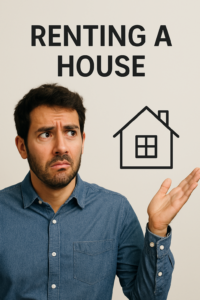Physical Address
304 North Cardinal St.
Dorchester Center, MA 02124
Physical Address
304 North Cardinal St.
Dorchester Center, MA 02124


Renting your first house in the UK? Between confusing contracts, strange smells in old flats, and something called an “EPC,” it’s easy to feel overwhelmed.
But don’t worry — this guide will walk you through everything you need to know in simple English, with a few laughs along the way. Let’s get started!
Start your search using trusted websites like:
Filter by:
📝 Tip: Set up email alerts so you don’t miss good listings — houses go FAST.
Think about:
Use Google Maps to check travel times.
If you rely on public transport, don’t move somewhere that shuts down at 6pm (unless you like walking home in the dark).
Visit Ofsted to search for school ratings by postcode.
Websites like Locrating can help you see schools on a map and how close they are to your future home.
🎒 A good school nearby = happy kids and higher property value (if you plan to buy one day).
Don’t just look at the rent! Include:
🎉 Pro Tip: Leave 10–15% wiggle room for surprises. Like lightbulbs. Or toilet brushes. Or life.
Online photos can be… let’s say “creative.”
What looks like a bright room might be a cupboard with a skylight. Visit the house must .Most reputable agencies wouldn’t let you rent a house till you have reviewed it . Check:
Take a friend if possible. They’ll spot things you might miss — or at least hold your snacks while you inspect.
Every rental must have an EPC rating. It tells you how energy efficient the property is.
⚡ Ask the landlord or agent for the EPC — it’s free and required by law.
You’ll usually pay a security deposit before moving in — this is normally 5 weeks’ rent.
The landlord MUST put your deposit into a government-protected scheme, like:
You must get:
🔒 Why it matters: If they don’t protect it properly, they could owe you up to 3x your deposit amount. Not bad for just reading the rules!
Before you unpack your socks:
🕵️ This protects you when it’s time to move out. If they try to blame you for that mystery wine stain, you’ve got receipts.
Seriously. Ask things like:
🎤 The only bad question is the one you didn’t ask and now costs you £100.
Here’s a mini checklist:
Renting a home for the first time in the UK can be scary, but you’re not alone. With the right info (and a sense of humour), you’ll avoid the common traps and find a place that feels like home — whether it’s a cosy flat or a house with a garden and questionable gnome collection.
Once you’ve found the perfect place, it’s time for the tenancy agreement — the boring bit with all the rules. But trust us, it’s important.
Most UK renters get a:
This is the most common rental contract in the UK. It usually includes:
Here are the two main types:
👉 Which is better?
📬 Always give notice in writing (email or letter) and keep a copy!
✅ Read every line (yes, even the boring ones)
✅ Ask about break clauses (these let you or the landlord end the contract early)
✅ Make sure your deposit protection details are included
✅ Don’t sign until you understand everything — it’s OK to ask questions!
Signing a rental contract without reading it is like saying “yes” to a mystery meal. It might be great… or it might be tuna jelly on toast. Ask first.
check list to download blog.
